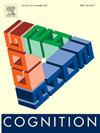韵律增强了成人连续语音流中统计依赖性的学习
IF 2.8
1区 心理学
Q1 PSYCHOLOGY, EXPERIMENTAL
引用次数: 0
摘要
外语听起来就像无缝的语音流,单词和短语之间没有停顿。这使得听者很难发现一门新语言的底层结构。然而,所有的口语都有旋律,音调、音节持续时间和重音的变化可以提供单词和短语边界的韵律线索。目前还不清楚成年人如何使用韵律线索来破解一门新语言的结构。在这里,我们研究了音调模式如何影响从新的人工语音流中学习相邻和非相邻统计依赖关系的能力。在包括两项研究在内的八个在线实验中,我们向母语为芬兰语的人展示了两分钟的简短语音流,这些语音流带有隐藏的概率结构,包含或不包含韵律音高模式。我们使用强制选择识别任务和信心评级来衡量学习成果。在研究1中,我们发现邻近依赖的学习在听者熟悉的韵律音高模式(即芬兰语的典型)下得到促进,而在听者不熟悉或随机韵律音高模式下则没有。在研究2中,我们发现更复杂的非相邻依赖关系只有在听众熟悉的韵律模式存在的情况下才能习得。有趣的是,韵律模式还能同时学习语音中的多个相邻和非相邻依赖关系。此外,它们增强了参与者记忆相邻依赖关系的信心,而不是非相邻依赖关系。综上所述,研究结果表明,成年人使用依赖于语言背景的韵律模式,以一种快速有效的方式从语音流中获取新的语言知识。这些发现支持了韵律在语言学习中发挥重要作用的观点,韵律使口语的潜在统计结构对听者来说更容易理解和学习。本文章由计算机程序翻译,如有差异,请以英文原文为准。
Prosody enhances learning of statistical dependencies from continuous speech streams in adults
Foreign languages sound like seamless streams of speech sounds without pauses between words and phrases. This makes it challenging for the listener to discover the underlying structure of a new language. However, all spoken languages have a melody, and changes in pitch, syllable duration and stress can provide prosodic cues about word and phrase boundaries. It is currently underspecified how adults use prosodic cues to crack the structure of a new language. Here, we investigated how pitch patterns affect the ability to learn adjacent and nonadjacent statistical dependencies from novel, artificial speech streams. In a series of eight online experiments along two studies, we presented native Finnish speakers with short, two-minute speech streams with a hidden probabilistic structure that did or did not include prosodic pitch patterns. We measured learning outcomes using a forced choice recognition task along with confidence ratings. In Study 1, we found that learning adjacent dependencies was boosted with familiar-to-listener (i.e., typical for Finnish language) prosodic pitch patterns but not with unfamiliar-to-listener or random prosodic pitch patterns. In Study 2, we found that more complex nonadjacent dependencies were only learned with the presence of familiar-to-listener prosodic patterns. Intriguingly, prosodic patterns also enabled concurrent learning of multiple adjacent and nonadjacent dependencies in speech. Moreover, they enhanced participants' confidence in remembering adjacent, but not nonadjacent, dependencies. Together, the results suggest that adults use language-background-dependent prosodic patterns to acquire novel linguistic knowledge from speech streams in a fast and efficient manner. The findings support the idea that prosody has an important role in language learning, making the underlying statistical structure of spoken languages more accessible and learnable for listeners.
求助全文
通过发布文献求助,成功后即可免费获取论文全文。
去求助
来源期刊

Cognition
PSYCHOLOGY, EXPERIMENTAL-
CiteScore
6.40
自引率
5.90%
发文量
283
期刊介绍:
Cognition is an international journal that publishes theoretical and experimental papers on the study of the mind. It covers a wide variety of subjects concerning all the different aspects of cognition, ranging from biological and experimental studies to formal analysis. Contributions from the fields of psychology, neuroscience, linguistics, computer science, mathematics, ethology and philosophy are welcome in this journal provided that they have some bearing on the functioning of the mind. In addition, the journal serves as a forum for discussion of social and political aspects of cognitive science.
 求助内容:
求助内容: 应助结果提醒方式:
应助结果提醒方式:


